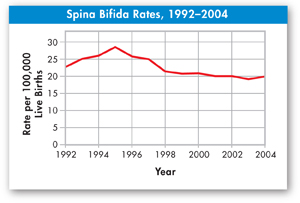
FIGURE 34–25 Preventing Spina Bifida In 1993, the U.S. Public Health Service recommended that women consume 4 mg of folic acid per day. Between 1996 and 1998, manufacturers of enriched grain products began to add folic acid to their products. Interpret Graphs Is there any indication that increase in folic acid intake had an effect on the rate of spina bifida cases?
dInfant and Maternal Health Although the placenta acts as a barrier to many harmful or disease-causing agents, some do pass through this barrier and affect the health of the embryo. The virus that causes AIDS can infect the developing fetus, and the virus responsible for rubella (German measles) can cause birth defects. Alcohol can permanently injure the nervous system, and drugs such as heroin and cocaine can cause drug addiction in newborn babies. Smoking during pregnancy can double the risk of low weight at birth, leading to other severe health problems. There is no substitute for professional medical care during pregnancy nor for responsible behavior on the part of the pregnant woman to protect the life within her.
From 1970 to 2000, the infant mortality rate in the United States decreased by about 65 percent. Many factors, including more women seeking early prenatal care and advances in medical technology, contributed to this decrease. Figure 34–25 shows how one recent public health initiative affected the incidence of a serious birth defect—spina bifida.
34.4 Assessment

-
Review Describe the process of fertilization.
Explain What is the role of the placenta?
Relate Cause and Effect How do the outcomes of gastrulation and neurulation contribute to human development?
-
Review List developments that occur in the fetus during months 4–6 and months 7–9.
Explain What is oxytocin, and what is its role in childbirth?
Apply Concepts Why do you think doctors recommend that women avoid many medications during pregnancy?
ANALYZING DATA
Review Figure 34–25 and answer the questions.
-
Interpret Graphs In what years did the incidence of spina bifida show the greatest decline?
Relate Cause and Effect What reasons could explain this decline in the incidence of spina bifida?

Table of Contents
- Formulas and Equations
- Applying Formulas and Equations
- Mean, Median, and Mode
- Estimation
- Using Measurements in Calculations
- Effects of Measurement Errors
- Accuracy
- Precision
- Comparing Accuracy and Precision
- Significant Figures
- Calculating With Significant Figures
- Scientific Notation
- Calculating With Scientific Notation
- Dimensional Analysis
- Applying Dimensional Analysis




